Aşgabat

Gleaming marbled showcase capital of wonders

The shining white city at the edge of the Karakum Desert, Ashgabat is the showcase capital of the gas-rich Central Asian state of Turkmenistan. If the country is Oz, this is doubtless the Emerald City. Ashgabat was founded in 1881 and was mostly destroyed by an earthquake in 1948, only to be almost completely rebuilt again since the collapse of the Soviet Union in 1991, in a modern, ostentatious, gilt-marble style as a beacon of progress to show the world. Despite all the glitz, Turkmenistan as a whole remains very much off the beaten path, with restrictive visa arrangements and authoritarian governance.
Our trip started and ended in Ashgabat in October 2016, with unseasonably cool but mostly sunny weather. Turkmenistan is politically strict but religiously relaxed for an Islamic nation, with nightclubs in the hotels and beer widely available from local shops. While the tour was guided, wandering around the city unaccompanied was no problem at all, save for being occasionally shouted at for photographing buildings we apparently weren’t supposed to.

Adjacent to the tomb of former president Niyazov, commonly known as the self-styled Turkmenbashi (the leader of the Turkmen), is Gypjak Mosque, easily the country’s grandest. It was completed in 2004 with a combination of local and Turkish labour, Türkiye being the closest trading partner of Turkmenistan outside of Central Asia.
Turkmenistan declared itself internationally neutral and was the first nation recognised by the UN as neutral in 1995. The Arch of Neutrality commemorates this event, standing above the photographed UN logo and goose-stepping guards. Originally the arch was closer to the city centre, and topped with a gold statue of Turkmenbashi which slowly rotated throughout the day to always face the sun.

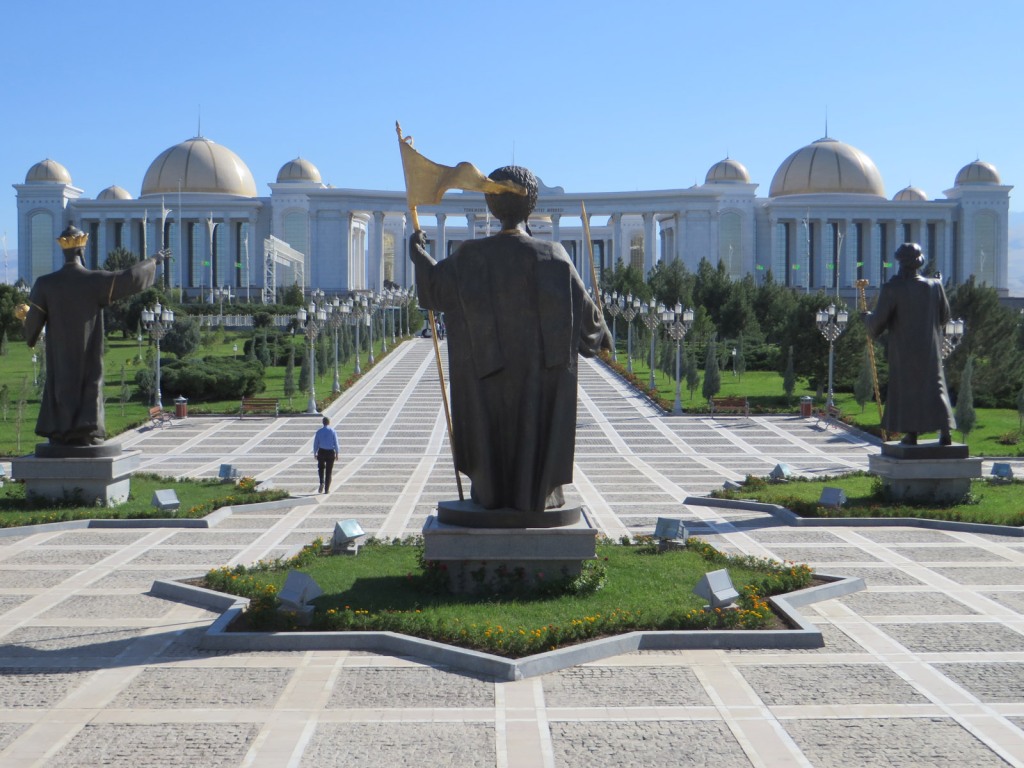
Ashgabat has no shortage of monuments to gawp at, but my favourite was probably the Independence Monument with its multitude of traditionally-armed statues guarding it. The monument commemorates Turkmenistan’s independence from the Soviet Union in 1991, a union the country did not enter willingly. This picture looks from the monument towards the State Cultural Centre.
Independence Monument itself with one of the stern archers watching over it – and you.
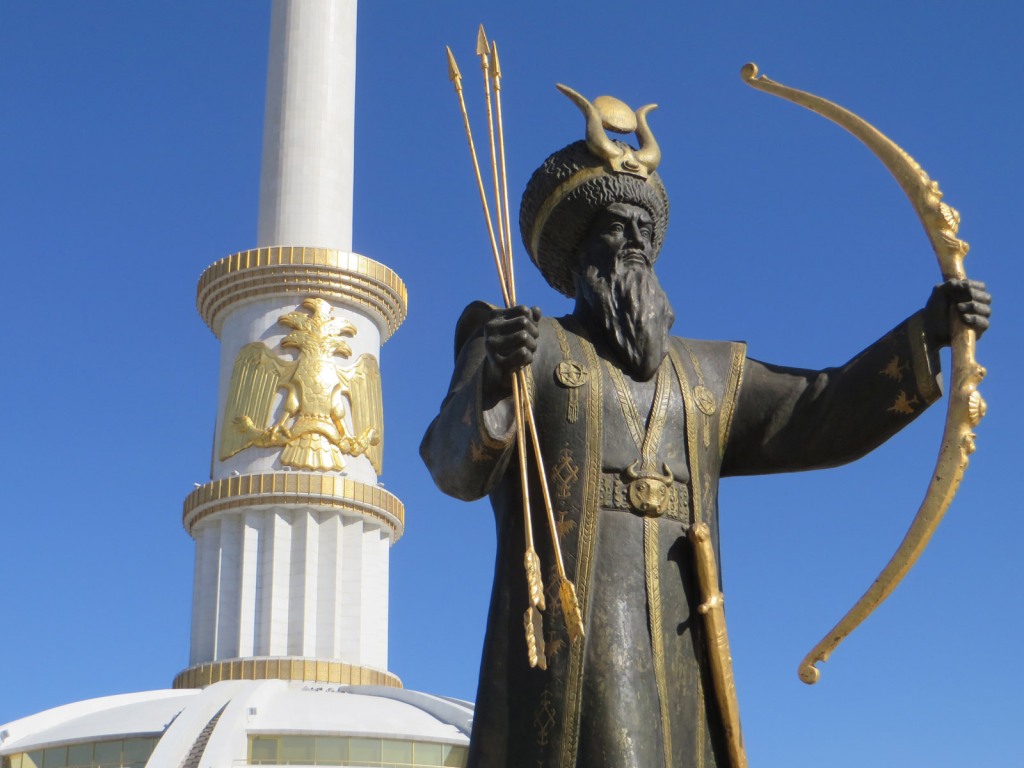

Many marbled buildings throughout Ashgabat may not be photographed by grubby tourists such as ourselves, largely the most interesting looking ministries surrounded by the most stern-faced guards. However, photographing buildings for entertainment poses no threat to national security, thus I snapped this one of several Drama Theatres we passed.
Some of the ministries themselves sat on streets which we couldn’t even walk along, such was the security presence. These buildings are near the presidential palace, and give a good impression of what much of the city centre looks like. Traffic was generally quite busy but well mannered, and all cars were modern.


The Yyldyz Hotel is built in a style similar to the Burj al-Arab in Dubai, and was proudly listed in our local guidebook as being constructed from seven tonnes of steel. While I suspect the hotel required slightly more raw material than just that, the guidebook could indeed have been referring to the monument to the building of the hotel, which is just a few roundabouts away.
The Turkmenistan State Circus has its home right across from our hotel, and is kept clean by sweeping babushkas day and night. We visited on our last night with tickets for forty pence, the cheapness belying the quality of the show, which was thoroughly entertaining.


The Palace of Happiness, or Bagt Kosgi, is so called as it’s the city’s top wedding venue, proven by the parties going on both times we stopped by. It also processes divorces, which only perpetuates the happiness. The eight-pointed star featured in the building’s architecture is repeated all over the country, and represents the sun that shines on the land of the Turkmen.
Fancy cars decked-out with carpets for one of the wedding parties we chanced upon. The drivers went zooming around the palace like lunatics, swerving all over the place with horns honking in celebration.


The wedding guests were having a great time, dancing around to music played by their band, which they had been thoughtful enough to invite too. This was a double wedding, with everyone dressed in their most colourful outfits.
Turkmenbashi certainly didn’t hold back on the construction of his personality cult, but much of that was toned down after he died in 2006, by the newly-designated leader, Gurbanguly Berdymukhamedov. However this may have been just so he couldn’t be outdone, and now golden monuments are springing up dedicated to the new president-for-life, such as this equestrian statue.
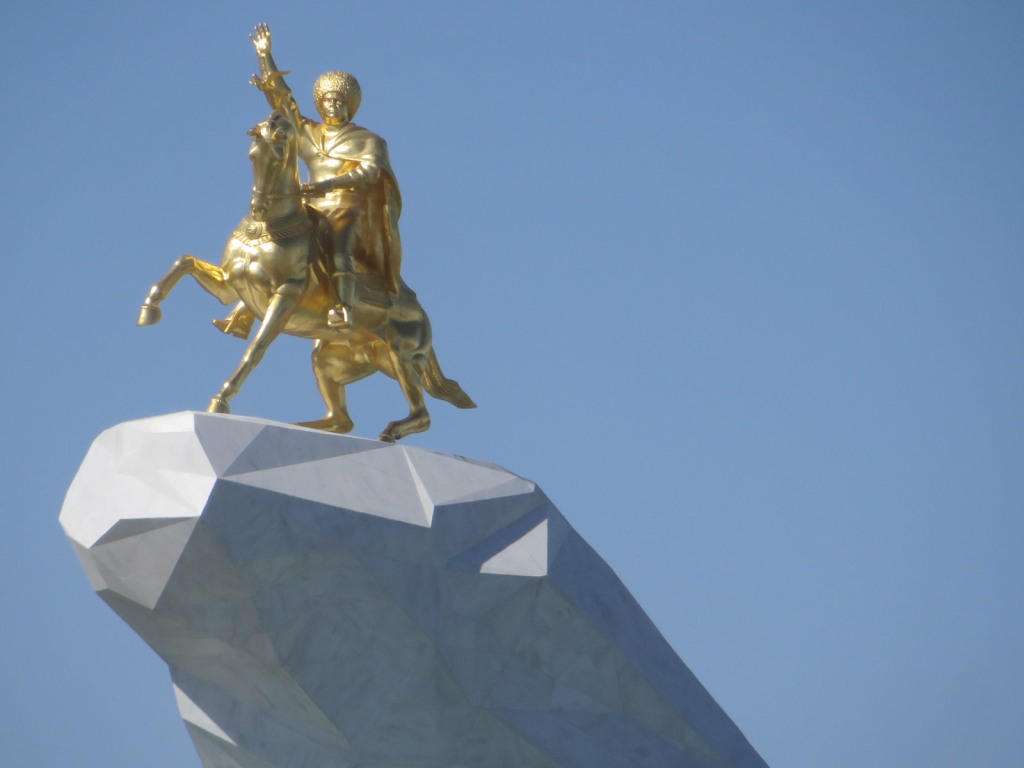
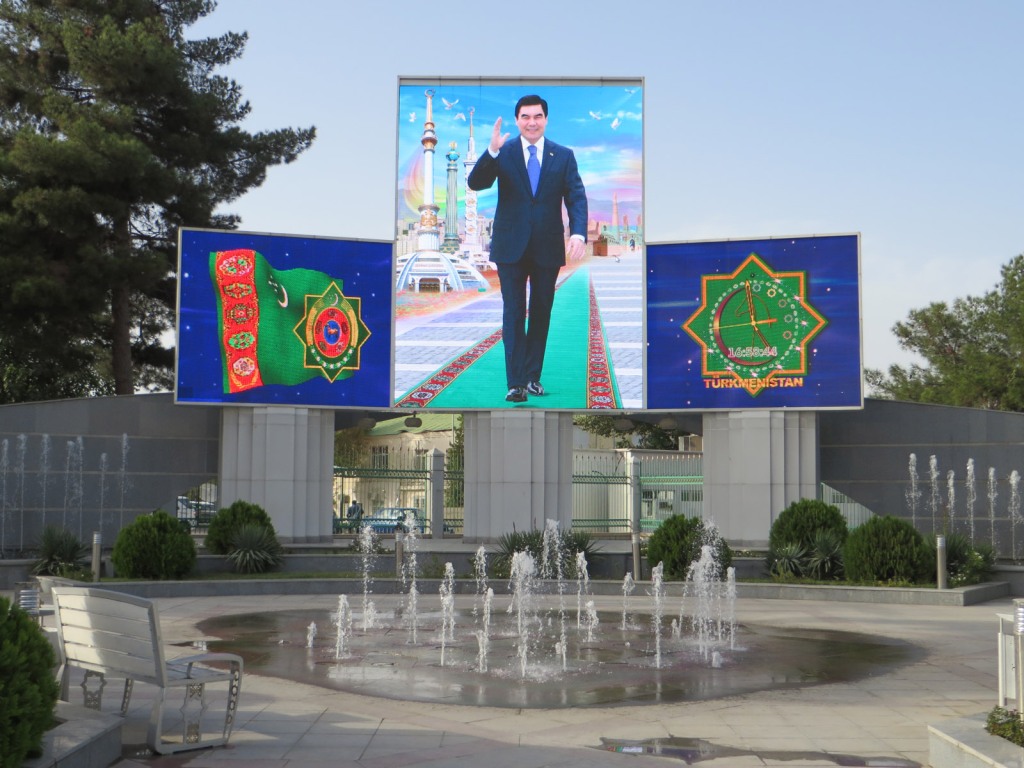
President Berdymukhamedov appears in perfect photographic form throughout the city, whether painted or digitally recreated such as on this electronic billboard.
Interestingly, another former leader of Turkmenistan still stands in effigy, one of a diminishing number of Lenin statues around the world. I’d always wanted to see a Lenin statue, since missing the one in Ukraine which was pulled down during the 2014 revolution only weeks before my visit, and missing seeing the man himself in person in Moscow, after we were too late to join the queue.
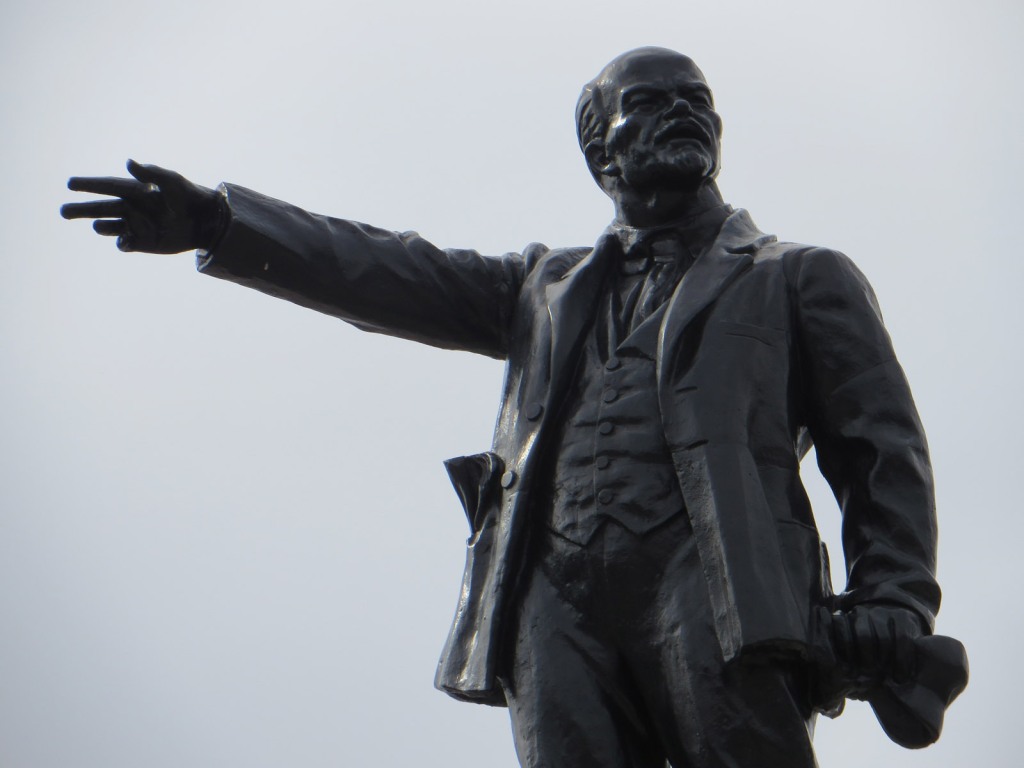

Very little physical evidence remains of Ashgabat’s past, not just for the forward-thrusting pace of development, but also following the 1948 earthquake which levelled the city and wiped out ninety percent of its population. One exception is Nisa Fort, just out of town and the ancient capital of the Parthian Empire. The site was settled perhaps as long as six thousand years ago, but eventually succumbed to the advances of Genghis Khan.
Turkmenistan is famed for its breed of Akhal-Teke horse, the most universally perfect horse breed and highly prized. We saw them in action at the races on our first morning in town (gambling not allowed, officially) and went to visit a stud farm outside the city, where we met these lads. I don’t think that’s his hair, as much as I’d like it to be.

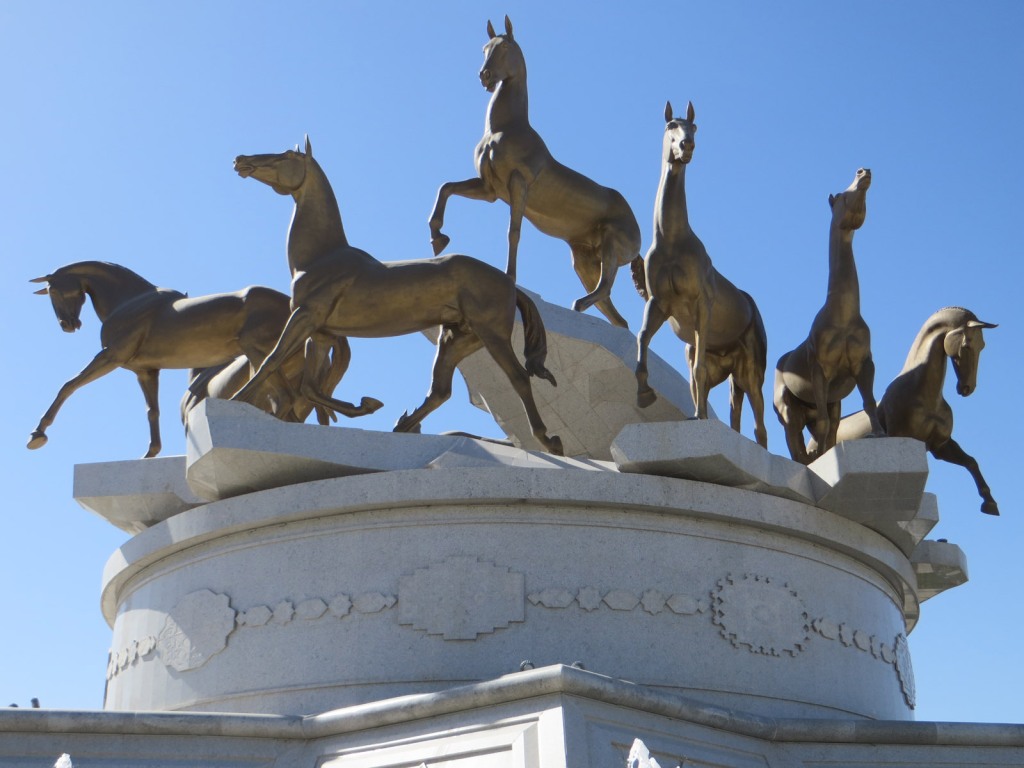
Reverence of horses in Turkmenistan is such that they even have their own monument, almost like they are bursting out of an iced cake.
The world’s largest indoor Ferris wheel is another of Ashgabat’s claims to fame – again the eight-pointed star features prominently, and the wheel turns its forty-seven metre diameter once every ten minutes. Similar to the London Eye and the Singapore Flyer, its rotation is slow enough that passengers step on and off without it stopping.


Turkmenistan TV Tower presides over the whole city, standing two hundred metres tall on a hilltop and featuring the world’s largest architectural eight-pointed star. This was as close as we could get for photos. Nearby is the “health walk”, a mountain trail which offers good views of the city, and is mandatorily walked by all government ministers once a year. Quite right too.
Ashgabat doesn’t hold back when it comes to neon, with much of the city lit by night in swathes of colour to rival Hong Kong or Las Vegas. This is the view from the TV Tower across the city.


The local brew, Berk, is a light lager widely available throughout the country. Although I think I preferred its fierce competitor, Zip.
Markets in Turkmenistan are clean and well organised almost to the point of the obsessive, I was very impressed. This is the Russian market in Ashgabat, which like much of the country, was difficult to photograph without being shouted at.


Our hotel, the Ak Altyn, which translates as “white gold”. It was built in the ’90s, and faces the Turkmenistan State Circus. Being early October, the pool was closed for the season, and although blue, I couldn’t see the bottom.
Ashgabat was building a shiny new railway station during our visit – but passenger and freight trains have been running for a long time, reaching the various neighbouring ‘Stans, and ultimately Moscow. The word Wokzal (station) is the same as in Russian, which was itself first applied after a Tsar visited London‘s Vauxhall station, and mistook the station’s name as the English word for any station. Or so the story goes.


Ashgabat had recently completed its showcase international airport terminal, opened only a few weeks before our arrival and shaped like an enormous bird. It was very impressive, but with the severe restrictions on visas for foreigners, and travel for locals, one wonders how much of its capacity will be used.
Created 2017 | Updated 2024
